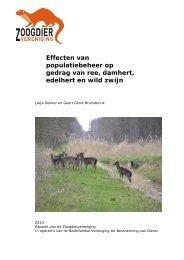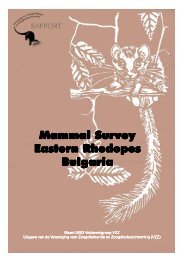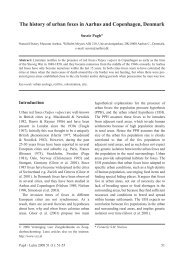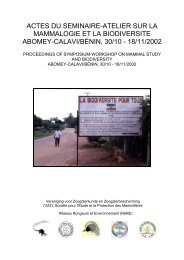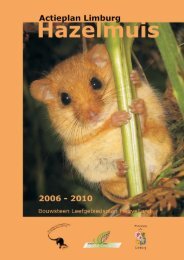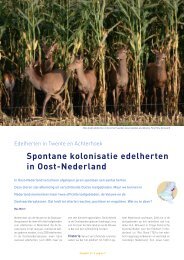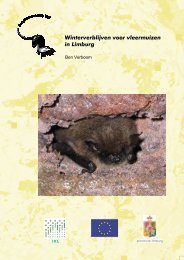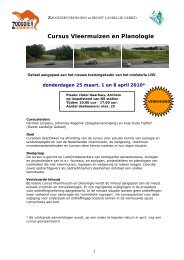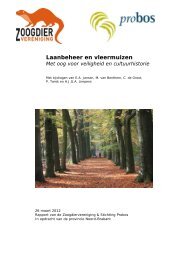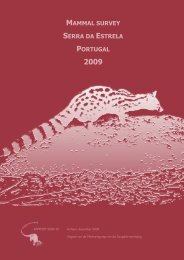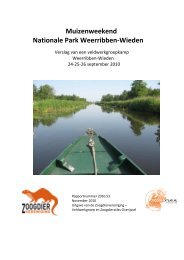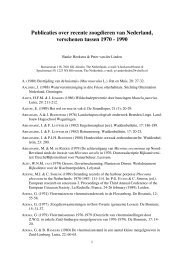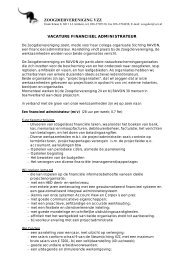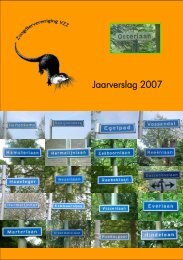Mammal survey Pol'ana - De Zoogdiervereniging
Mammal survey Pol'ana - De Zoogdiervereniging
Mammal survey Pol'ana - De Zoogdiervereniging
You also want an ePaper? Increase the reach of your titles
YUMPU automatically turns print PDFs into web optimized ePapers that Google loves.
3 BATS<br />
3.1 MIST NETTING by: Kamiel Spoelstra<br />
During the workshop, in total 16 netting attempts have<br />
been made in and around the Pol’ana reserve. In total<br />
120 bats of 17 species were caught: Myotis daubentonii<br />
(19), Myotis nattereri (1), Myotis mystacinus (6), Myotis<br />
brandtii (1), Myotis bechsteini (1), Myotis myotis (15),<br />
Myotis blythi (4), Myotis myotis/blythii (1), Plecotus auritus<br />
(4), Plecotus austriacus (1), Nyctalus lasiopterus (1),<br />
Nyctalus noctula (10), Nyctalus leisleri (13), Vespertilio<br />
murinus (10), Eptesicus serotinus (10), Eptesicus nilsonii<br />
(14), Barbastella barbastellus (8) and Pipistrellus<br />
pipistrellus (1). In all netting attempts nets were placed<br />
either over small streams or small ponds where relatively<br />
high number of bats can be caught. All bats caught rely<br />
on these places, so probably a strong bias may be<br />
present for species that hunt along streams. Indeed, with<br />
19 captures of M daubentonii this seems to be true. For<br />
other species, the capture above streams or ponds can<br />
be related to either drinking (ponds) or commuting (streams). In most cases, nets were placed over streams in<br />
places where the vegetation cover along the banks of the stream formed a corridor. Commuting bats tend to<br />
use these corridors for wind shelter. It is not likely that, because of the specific sample locations, a species<br />
present in the area has not been recorded during the workshop. However, the placement of the nets surely<br />
has influenced species composition.<br />
In 12 of the 16 netting attempts, the altitude was recorded by GPS. During the workshop, nets have been<br />
placed in locations between 622 and 876 meter above sea level. The presence of northern species like<br />
Vespertilio murinus and Eptesicus nilsonii is most likely due to the high altitude of the sample area.<br />
Unfortunately, there is not much to say about the influence of the altitude of the specific netting location on<br />
the species of bat that flew into the nets. For example, both Vespertilio murinus and Eptesicus nilsonii were<br />
present both in nets placed at 622 as well as 876 meter, the extremes in altitude. The habitat surrounding<br />
the netting locations may have had a more profound influence. For other species, there is no relation with<br />
presence and catch altitude as well. A repetitive and standardized netting project will potentially indicate<br />
altitude preferences between the different species present.<br />
Photo: Jeroen van der Kooy<br />
Nyctalus lasiopterus.<br />
Mist nets placed in and around a pond that is<br />
frequently visited by thirsty bats.<br />
The capture of a greater noctule (Nyctalus<br />
lasiopterus) is the third capture of this species in<br />
Slovakia. The specimen caught was an adult female<br />
bat. There were neither indications for recent lactation<br />
nor for lactation earlier in the season. It was caught<br />
above an open spot at a river in the Pol’ana reserve.<br />
Since N. lasiopterus hunts for large prey in open<br />
areas, it is most likely that it was caught during a<br />
drinking attempt, where the open area enabled the<br />
bat to approach the water surface.<br />
In Table 2 the total number of catches is presented,<br />
along with the gender and reproductive state. Also<br />
the minimum and maximum height of catchings<br />
above sea level is presented.<br />
Because of the number of bat species present and their densities in the Pol’ana reserve and its surroundings,<br />
this area may well be one of the most important bat areas in Europe and therefore deserves a strict<br />
protection and a bat friendly management.<br />
<strong>Mammal</strong> <strong>survey</strong> <strong>Pol'ana</strong> (Slovakia) 2005 13<br />
Photo: Kamiel Spoelstra



